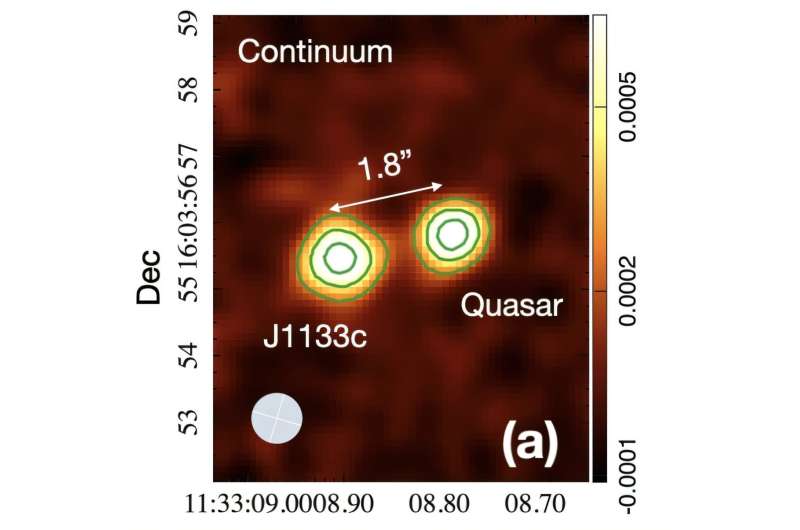
Astronomers from the Steward Observatory in Arizona and elsewhere report the discovery of a structure consisting of a quasi-stellar object (QSO) and a dusty star-forming galaxy (DSFG), linked by a bridge of ionized carbon. The finding of this unique system was detailed in a paper published November 11 on the pre-print server arXiv.
Quasars, or quasi-stellar objects (QSOs), are active galactic nuclei (AGN) of very high luminosity powered by supermassive black holes (SMBHs), emitting electromagnetic radiation observable in radio, infrared, visible, ultraviolet and X-ray wavelengths. They are among the brightest and most distant objects in the known universe, and serve as fundamental tools for numerous studies in astrophysics as well as cosmology.
Studies show that mergers may be significant triggers of quasar activity and star formation as up to half of the population of luminous high-redshift quasars are being linked to major merging events. In some cases, high-redshift quasars merge with dusty star-forming galaxies (DSFGs). Although such systems are rarely found, they are perceived by astronomers as essential for studying galaxy-quasar co-evolution during the reionization epoch.
Now, a team of astronomers led by Steward Observatory’s Yongda Zhu has found a new merger of this rare type. Using the Atacama Large Millimeter/submillimeter Array (ALMA), they observed 21 quasars and by analyzing ionized carbon emission ([C II] 158µm emission line) they found that one of them, known as J1133+1603, is connected with a compact and dust obscured galaxy, which received designation J1133c.
“ALMA observations reveal a prominent [C II] bridge connecting the quasar and DSFG, indicating ongoing interaction at a projected separation of 1.8′′ (∼10 proper kpc),” the researchers explained.
The system is at a redshift of 5.63 and the companion DSFG appears to lie southeast of the quasar, about 32,600 light years from it. This is a relatively small separation between the two objects when compared to other well-studied quasar-DSFG pairs.
According to the study, the C II bridge connecting J1133+1603 and J1133c suggests active interaction, therefore an ongoing merger process. This scenario is further supported by the detection of an extended emission north of the quasar.
Moreover, the analysis of C II emission found that J1133c has a luminosity at a level of 14.3 tredecillion erg/s. This is nearly five times greater luminosity than that of the quasar, which suggests an intense star formation or potential activity of an active galactic nucleus (AGN). In general, C II is one of the brightest emission lines from star-forming galaxies and is an excellent tracer for star formation.
The observations also found that J1133c showcases relatively compact morphology of both its dust continuum and C II emission, and its star-formation rate was inferred to be approximately 1,000 solar masses per year. The authors of the paper assume that such intense star formation and the potential AGN activity in J1133c could result from an ongoing merger process.
More information:
Yongda Zhu et al, Discovery of a Unique Close Quasar-DSFG Pair Linked by a [C II] Bridge at z=5.63, arXiv (2024). DOI: 10.48550/arxiv.2411.06698
Journal information:
arXiv
© 2024 Science X Network
Astronomers discover a unique quasi-stellar object–dusty star-forming galaxy system (2024, November 18)
retrieved 18 November 2024
from https://phys.org/news/2024-11-astronomers-unique-quasi-stellar-objectdusty.html
part may be reproduced without the written permission. The content is provided for information purposes only.